(844)698-7277 Raccoon Removal and Control can help you get rid of raccoons in the attic, chimney, crawl space, or yard. We provide humane raccoon removal, trapping, prevention and can clean up raccoon poop. We are the best raccoon trappers in Los Angeles and Orange County. We know how to keep raccoons away by using the best techniques available. Raccoons are usually labeled as a nuisance wildlife species due to their destruction and presence on private properties. The most common calls include the following:
- Raccoons digging up the garden
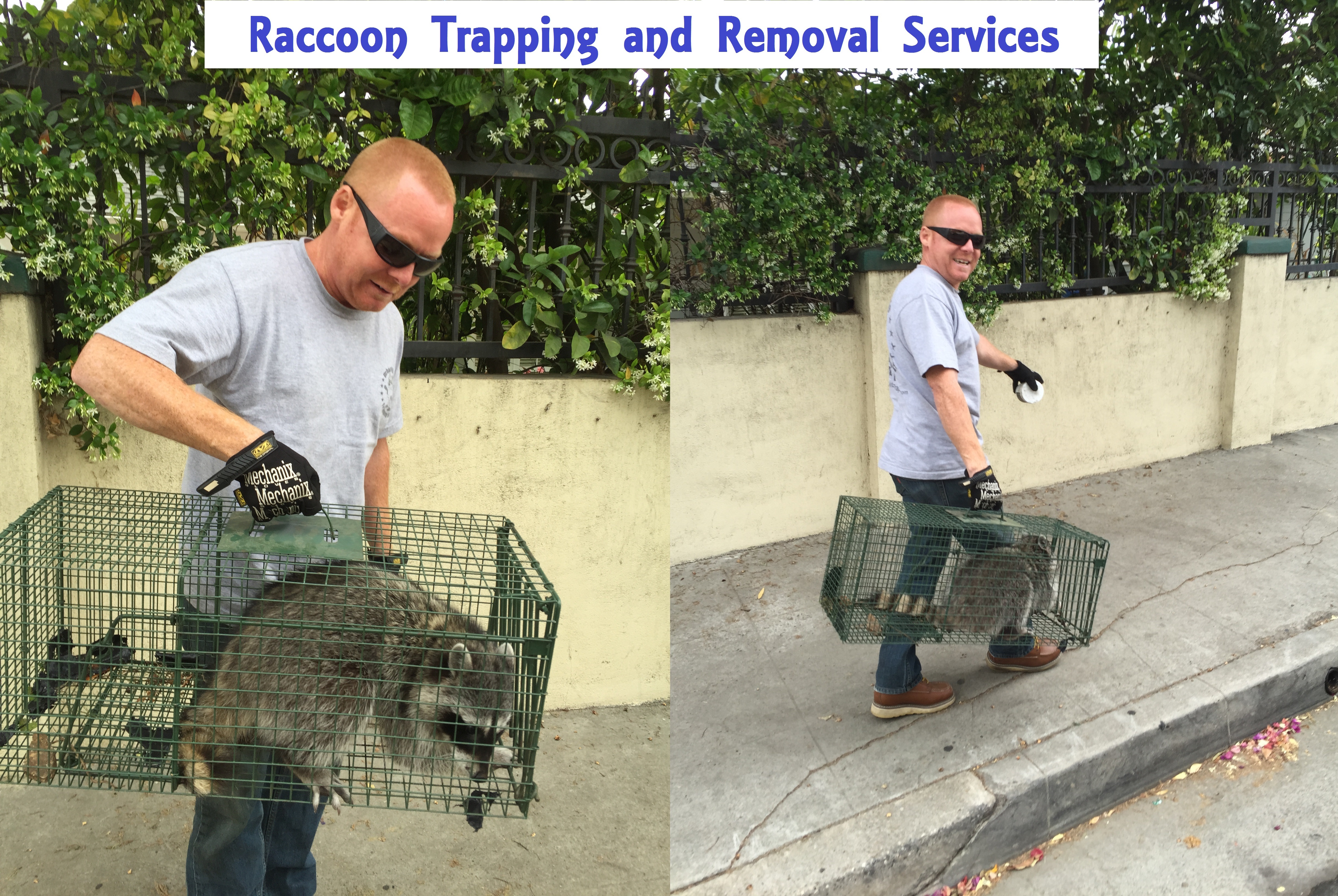
- Raccoons rolling up the sod or grass
- Raccoons living in the attic
- Raccoons living in the crawlspace
- Raccoons living in the chimney
- Raccoons stealing pet food or bird seed
- Raccoons entering through pets door
- Dead raccoon in the attic or crawlspace
- Raccoons presence alarming pets
- Sick or rabid racoons
It happens, So many people wish to have the nuisance raccoons trapped and removed by a Raccoon Trapping and Removal Company.
How to Get Rid of Raccoon
Raccoon Trapping Tips: Trapping pest raccoons is probably one of the most common raccoon removal techniques used nationwide by homeowners and professional raccoon removal companies. In order to be successful capturing raccoons in a humane raccoon trap, you’ll want to know the law’s in your hometown, call your city animal control shelter. In most states and cities you cannot trap and removal raccoons without a license from the department of Fish and Wildlife. In that case you will have to hire a raccoon removal specialist. Trapping is always a good option for raccoon removal. It’s not always simple tho and do-it-yourself raccoon trapping for an inexperienced trapper can be challenging.
Urban Wildlife Trapping Experts is a wildlife control company located in Los Angeles County. We are the best at solving conflicts with nuisance wildlife. We are trained wildlife staff and licensed by the Department of Fish and Wildlife in California. We are highly experienced and can capture raccoons, remove raccoons, exclusion of raccoons, repair raccoon damages, cleanup raccoon poop, and more. We specialize in humane raccoon trapping and removal solutions to complete every job. Basically, we can solve any raccoon problem at your home or business place. We are committed to providing safe, effective and humane solutions to all nuisance wildlife problems in private homes and commercial properties throughout Los Angeles County and surrounding area’s (in California). Los Angeles Raccoon Removal – We know How-To Get Rid Of Raccoons – Raccoons in the Attic Raccoons on the Roof – Raccoons in the Yard – Raccoons in the Crawl Space – Raccoons in the Chimney – Raccoons in the Wall – Raccoons in the Pool
CALL 1-844-698-7277
After receiving your call to us, our courteous and friendly raccoon removal staff will do an initial inspection of property, then only use humane raccoon removal techniques. The two most common techniques we use are cage trapping or removing the raccoon by hand from your property. We offer exclusion services to seal any openings the raccoons may have found or caused. This will keep other pest from re-entering your attic, crawlspace or walls on your property. Our professionally-trained wildlife raccoon specialist will do a good job taking care of you, your family, and your property.
We witness daily on how raccoons can destroy soffits, vents, screens and wiring. We know from firsthand experience that raccoons do significant damage to your home or business. Raccoons urine and fecal matter deposits can be a health hazard. There are many wild raccoons living in North America, some of which are dangerous or even rabid. Give us a call! We can arrange an inspection and a service call to remove all raccoons safely and humanely. We also can do repairs to keep raccoons out. Thorough attic restoration services are always a good option to eliminate any nesting, poop, and oils (pheromone). In minor cases, a light clean out will work just fine. Below is more information about how we handle raccoon problems.
Raccoon Yard Control
Why Are Raccoons Digging Up Your Lawn or Garden?  Raccoon Yard Control Raccoons love grass or sod. what do raccoons eat? Hungry raccoons are digging up your lawn to eat fresh worms and grubs under your lawn. Raccoon rolling up sod is probably one of the most common calls we deal with in Los Angeles and Orange County. Other wildlife such as opossums and skunks do similar, but do less damage to your yard then a raccoons would do. If your lawn looks like the photos above, more than likely it’s raccoons. Urban Wildlife Trapping Experts can help you remove the raccoon rolling up or tearing up your grass. We will come out to your home or business place and help you take control over your property. Step 1. Set up a sturdy 12W x 12H x 32L raccoon traps. Step 2. Capture and remove the Raccoons. Step 3. Repeat raccoon trapping method.
Raccoon Yard Control Raccoons love grass or sod. what do raccoons eat? Hungry raccoons are digging up your lawn to eat fresh worms and grubs under your lawn. Raccoon rolling up sod is probably one of the most common calls we deal with in Los Angeles and Orange County. Other wildlife such as opossums and skunks do similar, but do less damage to your yard then a raccoons would do. If your lawn looks like the photos above, more than likely it’s raccoons. Urban Wildlife Trapping Experts can help you remove the raccoon rolling up or tearing up your grass. We will come out to your home or business place and help you take control over your property. Step 1. Set up a sturdy 12W x 12H x 32L raccoon traps. Step 2. Capture and remove the Raccoons. Step 3. Repeat raccoon trapping method.
Raccoons In The Attic Solutions
Why do raccoon live in my Attic? It provide perfect shelter from elements and predators. not only does your attic provide shelter, it a perfect habitat for female raccoons t give birth to their young.
 How-To Get Rid Of Raccoons In your Attic: There can only be two scenarios here. 1. Adult raccoons in the attic or 2. A female raccoons with cute little raccoon babies. For starters, you need to physically go into the attic and thoroughly search the attic to determine which case is yours. Raccoons? or Female Raccoon w/ Babies?.Warning: Raccoons will attack if cornered or if mother raccoon feels that her babies are in danger. Step-by-step how to get rid of raccoons in the attic listed below:
How-To Get Rid Of Raccoons In your Attic: There can only be two scenarios here. 1. Adult raccoons in the attic or 2. A female raccoons with cute little raccoon babies. For starters, you need to physically go into the attic and thoroughly search the attic to determine which case is yours. Raccoons? or Female Raccoon w/ Babies?.Warning: Raccoons will attack if cornered or if mother raccoon feels that her babies are in danger. Step-by-step how to get rid of raccoons in the attic listed below:
- Getting Rid of Raccoons in your Attic: Step 1. Determine where the raccoons are getting into your attic. The raccoons will enter through eaves, soffits, roof vent, or wall siding. Step 2. After locating the raccoons entryway to your attic, Set up and secure a sturdy trap by the attic hole. For raccoon bait, use peanut butter or sweets foods. Step 3. Once we have trapped and removed all of the raccoons. Step 4. Then secure all the attic holes using high grade 1/4″ steel mesh, wood, or sheet metal. Step 5. When it come to clean up raccoon poop in your attic, we always use a respirator, goggles, and gloves. If you really want to show your attic some love, run a fogger machine with an enzyme cleaner. This will help eliminate raccoon oils, urine, and smells, that might attract another raccoons to your property.
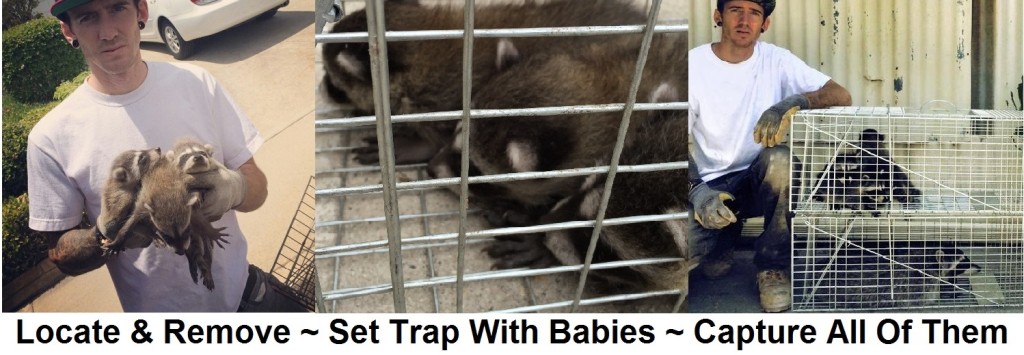
- Getting Rid of a Female Raccoon with babies in your Attic: Step 1. Physically go into the attic locate and remove the baby raccoons by-hand and then place them in a padded box. Step 2. Once the baby raccoons are out of the attic. Then place them in the back of a trap using them as bait. use a trap divider to hold them in place. We securely set up the trap with the babies as bait at the entry hole to your attic . Step 3. Once we captured and removed the whole family of raccoons all at once. Step 4. Determine where the raccoons are getting into your attic. Raccoons will usually enter through eaves, soffits, roof vents, or wall siding. Step 5. Now secure all the attic holes using high grade 1/4″ steel mesh, wood, or sheet metal. When cleaning up raccoon poop in your attic, always use a respirator, goggles, and gloves. Step 6. And if you really want to show your attic some love, run a fogger with enzyme cleaner. This will help eliminate raccoon oils, urine, and smells, that might attract another raccoons to your property.
 How-To Keep Raccoons Out Of Your Attic: Step 1. Determine where raccoons can potentially into your attic. They usually will enter through eaves, soffits, roof vents, or wall siding. Step 2. After locating the potential raccoon entryways. Now secure all the attic holes using high grade 1/4″ steel mesh, wood, or sheet metal.
How-To Keep Raccoons Out Of Your Attic: Step 1. Determine where raccoons can potentially into your attic. They usually will enter through eaves, soffits, roof vents, or wall siding. Step 2. After locating the potential raccoon entryways. Now secure all the attic holes using high grade 1/4″ steel mesh, wood, or sheet metal.
Raccoon Eviction Liquid
Are You Having Problems With Raccoons Nesting Or Breeding On Property? How-To Get Rid Of Raccoon In the Attic – Raccoon Removal and Control can help you get rid of nesting female raccoon with baby raccoon at you home or business place. We only use humane raccoon methods and techniques for eviction or removal. Step 1. locate all entryways (attic or crawlspace) and seal every hole, except for the main entryway that the family of raccoons are using. Step 2. then apply a male raccoon scented pheromone in the space where raccoons are living. Step 3. We wait 1-5 days until the family of raccoons fully relocate themselves on their own. Step 4. Five day later, We then do our final inspection of the attic or crawlspace, where the family of raccoons was living to insure there are no more raccoons in your attic or crawlspace. Now that we know there’s no more raccoon in your attic or crawlspace. Step 5. Repair the main entry way. Step 6. Clean-up any feces or nesting that the family of raccoons left behind. We offer Full Attic Restoration services
How-To Get Rid Of Raccoon In the Attic – Raccoon Removal and Control can help you get rid of nesting female raccoon with baby raccoon at you home or business place. We only use humane raccoon methods and techniques for eviction or removal. Step 1. locate all entryways (attic or crawlspace) and seal every hole, except for the main entryway that the family of raccoons are using. Step 2. then apply a male raccoon scented pheromone in the space where raccoons are living. Step 3. We wait 1-5 days until the family of raccoons fully relocate themselves on their own. Step 4. Five day later, We then do our final inspection of the attic or crawlspace, where the family of raccoons was living to insure there are no more raccoons in your attic or crawlspace. Now that we know there’s no more raccoon in your attic or crawlspace. Step 5. Repair the main entry way. Step 6. Clean-up any feces or nesting that the family of raccoons left behind. We offer Full Attic Restoration services
What is raccoon eviction liquid? Raccoon Eviction Fluid is a natural byproduct of male raccoon, a predator to female raccoons during the birthing period. When placed in a den area, the female senses that a danger to her young is nearby. Raccoon eviction liquid works best between February-August. When eviction techniques are used, do not expect the raccoon to leave until well after dark.
More Information about Mother Raccoons and Baby Raccoons:
Raccoons can breed anytime from December to June, but most of them breed around February. Gestation is 63-65 days, with most babies being born in April or May. Litter size is usually 2-5 babies. At about 8 weeks old, the young usually leave the den and follow the mother to a new location. Young are weaned at about 12 weeks and disperse in the fall or early winter; or they may stay with the mother until the following spring. We do not recommend you try to remove a Raccoon from your property on your own! between February or July. A raccoon may have babies hidden in its nest, which an inexperienced trapper may overlook. When a mother raccoon is removed, the babies will die… this opens up a whole new can of worms for you, the property owner!
Raccoon Damage Control And Repairs
Have Raccoons Damages your property seeking shelter?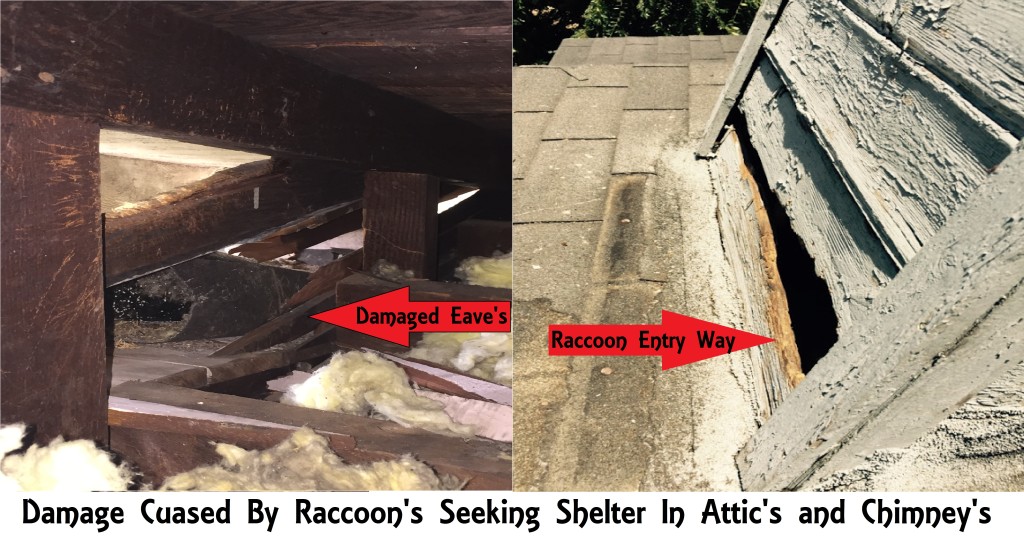 We witness daily on how raccoons can destroy rooflines, roof eave’s, wall siding, soffits, vents, screens and wiring. We know from firsthand experience that raccoons do significant damage to your home or business. We can locate and repair any damages caused by raccoons at your property. Not only can we repair it, we will make sure no wildlife can get into your home, attic, walls, or crawlspace.
We witness daily on how raccoons can destroy rooflines, roof eave’s, wall siding, soffits, vents, screens and wiring. We know from firsthand experience that raccoons do significant damage to your home or business. We can locate and repair any damages caused by raccoons at your property. Not only can we repair it, we will make sure no wildlife can get into your home, attic, walls, or crawlspace.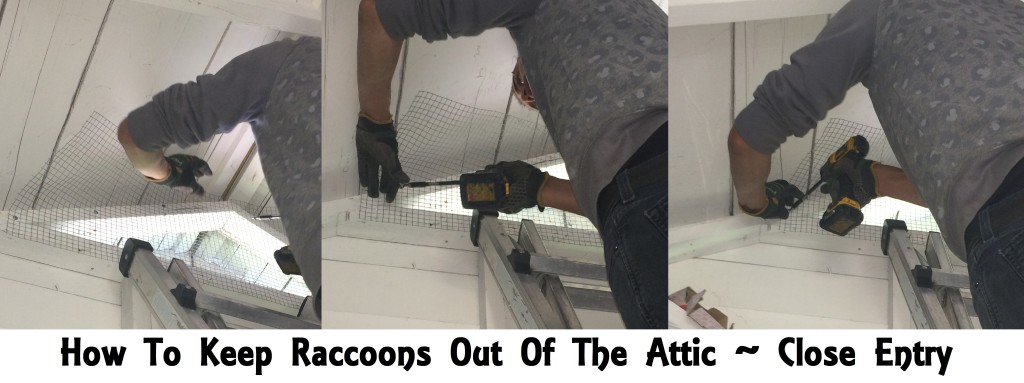 Step 1. Do an initial inspection of locating every hole, check the attic, crawlspace to make sure there are no raccoons or other animals present. Step 2. Repair all holes or raccoon entry ways, using only high grade materials to ensure raccoons or other wildlife won’t re-enter your attic. Step 3. Remove raccoon feces, nesting, damaged insulation, etc. Step 4. Attic fogging with a disinfectant agent in all contaminated areas of your property is the key step for a healthy attic or crawlspace. Fogging will help get rid of raccoon oils, grease and urine that has dried out from the raccoons, these are pheromone that attract other animals or raccoons if left behind.
Step 1. Do an initial inspection of locating every hole, check the attic, crawlspace to make sure there are no raccoons or other animals present. Step 2. Repair all holes or raccoon entry ways, using only high grade materials to ensure raccoons or other wildlife won’t re-enter your attic. Step 3. Remove raccoon feces, nesting, damaged insulation, etc. Step 4. Attic fogging with a disinfectant agent in all contaminated areas of your property is the key step for a healthy attic or crawlspace. Fogging will help get rid of raccoon oils, grease and urine that has dried out from the raccoons, these are pheromone that attract other animals or raccoons if left behind.
Raccoon Feces and Health Risk
Are You Looking To Have Your Attic Cleaned-Out and Free Of Raccoon Feces? (we offer Full Attic Restoration Services)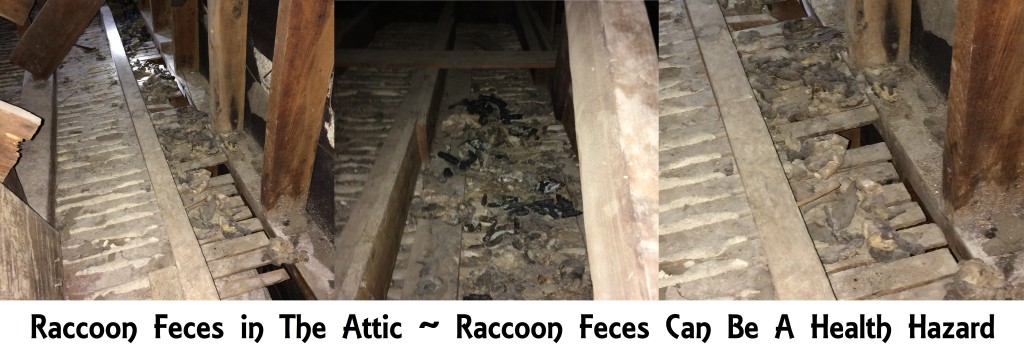 Raccoons Feces within the structure of your home or building can be scary for most property owners. We can help you fully restore your attic and remove raccoon poop for your attic. Raccoon pooping on the roof, in the attic, or in crawl spaces can be a health hazard. Especially when the raccoons are pooping on or around your central air system. CAUTION: Blowing raccoon feces diseases through your A/C unit or heating unit can be harmful to you or your family. We can clean out raccoon feces and install new attic insulation at you location. Here are process for attic restoration. Step 1. Remove raccoons from attic and crawlspace, if any are present(Trapping Raccoon). Step 2. Seal up any openings or holes that lead into the affected areas, this will keep other pest from re-entering your attic, crawlspace or walls and causing more damage. Step 3. Remove raccoon feces, nesting, damaged insulation, etc. Step 4. Attic fogging with a disinfectant agent in all contaminated areas of your property is the key step for a healthy attic or crawlspace. fogging will help get rid of oils, grease and urine that has dried out from the raccoons, these are pheromone that attract other animals or raccoons if left behind.
Raccoons Feces within the structure of your home or building can be scary for most property owners. We can help you fully restore your attic and remove raccoon poop for your attic. Raccoon pooping on the roof, in the attic, or in crawl spaces can be a health hazard. Especially when the raccoons are pooping on or around your central air system. CAUTION: Blowing raccoon feces diseases through your A/C unit or heating unit can be harmful to you or your family. We can clean out raccoon feces and install new attic insulation at you location. Here are process for attic restoration. Step 1. Remove raccoons from attic and crawlspace, if any are present(Trapping Raccoon). Step 2. Seal up any openings or holes that lead into the affected areas, this will keep other pest from re-entering your attic, crawlspace or walls and causing more damage. Step 3. Remove raccoon feces, nesting, damaged insulation, etc. Step 4. Attic fogging with a disinfectant agent in all contaminated areas of your property is the key step for a healthy attic or crawlspace. fogging will help get rid of oils, grease and urine that has dried out from the raccoons, these are pheromone that attract other animals or raccoons if left behind.
The attic is fogged via a special electric-powered atomizing mist machine, which dispenses the special enzyme-based biohazard cleaner. This special cleaner destroys organic matter specifically, without affecting the structure. It kills the pathogens and breaks down urine, grease, and animal poop, effectively “digesting” it with time. It renders the waste inert, and importantly, eliminates the pheromone odor left behind by the animals. It’s very important to get rid of the animal smell, because the scent of animals living in an area can attract new animals of the same kind, or even predator animals.
HEALTH CONCERNS:
Raccoon Removal, Raccoon Control, Spreading Diseases Through Raccoon Feces
Nuisance raccoons cause health concerns for You, your family and your pets. Most diseases are transferred only through direct contact, although the droppings within a structure can cause extremely harmful diseases (Histoplasmosis, Hanta-virus, Roundworm, Giardia lambliaetc.). Simply being near a raccoon is not considered a risk. Pets should receive regular vaccinations from your veterinarian to reduce risk. Report any direct contact with your pets to your county’s animal control office. Any human contact (scratch, bite, etc.) with raccoons should be reported to the county health department immediately as well.
Full Description of Urban Raccoon:
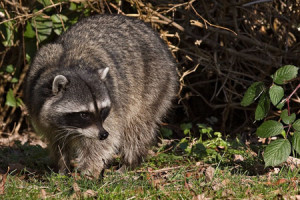 Raccoons in California are fairly easy to identify, Raccoons have a black mask with a ringed tail. Raccoons will mature in about a year, and Raccoon may eventually reach weights of 20-35 pounds in the state California. Raccoons in California are on the small side compared to Raccoons in other States.
Raccoons in California are fairly easy to identify, Raccoons have a black mask with a ringed tail. Raccoons will mature in about a year, and Raccoon may eventually reach weights of 20-35 pounds in the state California. Raccoons in California are on the small side compared to Raccoons in other States.
Raccoons are excellent climbers and are very Smart. we can’t forget how strong Raccoons are, they have hands like ours which allows Raccoons to get better leverage for their destruction to your home and property. California Raccoons are Nocturnal, which means, Raccoons are most active at night, when you and your family are sleeping. California Raccoons seeking Shelter, to hind during the daylight hours in thick vegetation, barns, chimneys, crawl spaces, walls, holly trees and attics. They are omnivores, and will feed on almost anything they can get their hands on. They are generally very smart and very intelligent. California Raccoons very well in Comfortable with around people.
Raccoons are opportunistic omnivores. Raccoons will take almost any opportunity to get food sometimes crawling through your pet doors or knocking over your trash cans. Like Opossums, Raccoons can be aggressive animals-especially when the raccoon is cornered or threatened. Raccoons will make their home in your attic, underneath eaves in your roof, in your chimney and even within your walls. We do not recommend you try to remove a Raccoon from your property on your own! A raccoon may have babies hidden in its nest, which an inexperienced trapper may overlook. When a mother raccoon is removed, the babies will die… this opens up a whole new can of worms for you, the property owner!
Raccoons Attack in Los Angeles
From NPR News, it’s DAY TO DAY.
A group of masked marauders prowling the streets of Los Angeles, rifling through garbage and mauling neighborhood pets? They’re gangs of raccoons and they’re testing the patience of many southern California communities.
NPR’s Karen Grigsby Bates reports.
(Soundbite of water running)
KAREN GRIGSBY BATES: To us this is just a tile fountain in the courtyard of an urban home. It provides a pleasant filter to the city noise and the traffic just beyond. But to raccoons it’s the first stop in the all-you-can-eat buffet that the nationhood provides. This particular fountain is attached to my house, which is right in the middle of the city.
But raccoons aren’t only my problem. The local news this week has run several stories about a 50-pound dog that got mauled by a family of raccoons on her own front porch.
(Soundbite of news report)
Unidentified Man: Larna and her husband were asleep in their home on the Venice Canal when a family of raccoons tried to get in through this open window. Larna says she came out to find her 50-pound Dalmatian Charlie pinned on her back by a large raccoon.
Ms. LARNA HARTNACK (Venice, California Resident): She’s a strong dog but she couldn’t get up.
BATES: But raccoons don’t usually attack dogs or humans, says John Hadidian. He’s director of the Urban Wildlife Program for the Humane Society of the United States and he should know – before his current job, Hadidian worked for the U.S. Forest Service and conducted a 10 year study of raccoons in their urban habitat.
Mr. JOHN HADIDIAN (Humane Society of the United States): They’re what I call the North American primate. I mean, they’re very intelligent. They have a lot of manual dexterity, they’re good problem solvers.
BATES: While raccoon size varies from coast to coast, in cold places like Maine and Minnesota, Hadidian says raccoons can get up to 70 pounds. One thing remains constant, raccoons are very competent foragers. They even take note of where the food is – from trees or garbage bins – for future reference.
Mr. HADIDIAN: So they figure these things out. They have a regular route that they follow at night to look for the most, you know, dependable and reliable food sources. And if your garbage is going out on Tuesday night they’re probably going to learn that to take advantage of it.
Ms. MARGARET ZUMWINKEL(ph) (Resident, Los Angeles): I’ve got an apricot tree out there. And then over here is my lemon tree. And then I’ve got plum tree. And then I’ve got figs up there I never see because the squirrels get them all.
BATES: Margaret Zumwinkel’s backyard contains everything to keep a raccoon happy. Full watering cans, luscious undergrowth, and trees full of fruit. It’s a raccoon magnet, says Captain Wendell Bowers of L.A. County Animal Control’s Wildlife Division.
Captain WENDELL BOWERS (L.A. County Animal Control Wildlife Division): You know, we want our yards to look really nice and that, so we end up planting fruit trees, we put in little vegetable gardens, we put in koi ponds. These are all things that attract all wildlife, including raccoons.
BATES: Bowers says humans have to recognize that raccoons are a permanent part of the landscape and modify their behavior accordingly. Don’t feed them. Don’t harm them. And do scare them with noise and lights if you don’t want them around.
Captain BOWERS: You know, this wildlife was here before we got here. It’s going to be here after we’re gone. We just don’t want to encourage them to lose the fear of man. I want them to run away when we walk out the door.
BATES: Larna Hartnack, owner of the injured dog, has another suggestion.
Ms. HARTNACK: I think that they should be trapped and removed to the hills. I think the least that, you know, that could be done is have them trapped and neutered so that they’re not procreating in the canals.
BATES: But Wendell Bowers says that’s impractical given local wildlife laws.
Captain BOWERS: Either we relocate them within a half a mile of where we catch them, which means they’re coming back to your house, or to euthanize them – to put them to sleep. And nobody really wants to put healthy wildlife to sleep just because they’re taking the koi out of your pond.
BATES: So, lock your trashcans, close your windows, leave the dog food and the dog inside at night. And skip the koi ponds. Or plan to hear a lot more of this.
(Soundbite of raccoons)
BATES: Karen Grigsby Bates, NPR News, Los Angeles.
(Soundbite of raccoons)
(Soundbite of music)
CHADWICK: And we’ll be right back with more from DAY TO DAY.